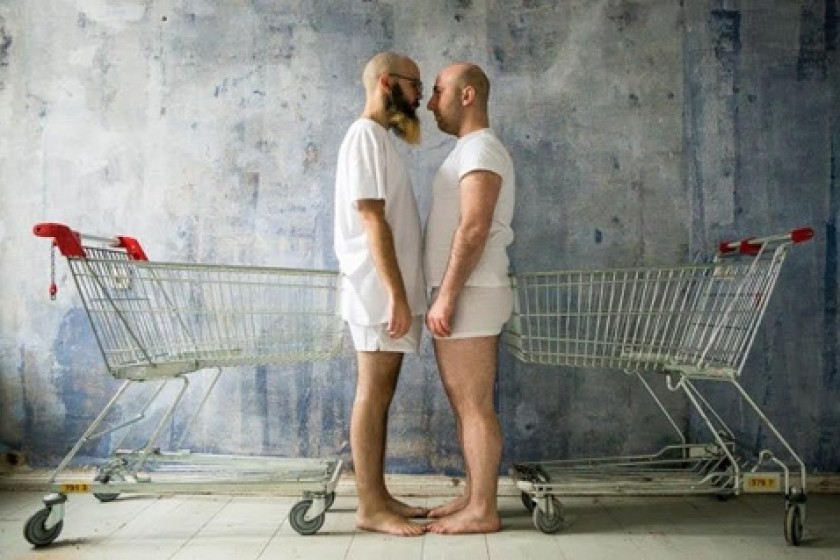
Challenges for Art in Armenia: View from Three Contemporary Artists and an Art Curator
By Karine Aghajanyan
"Art can have both aesthetical meaning as well as the potential for social impact", according to Misha Badasyan, Manan Torosyan and Petra Hultman; the three artists I talked to regarding the contemporary art scene in Armenia.
I recently sat down with them to discuss their thoughts on the challenges they face regarding art in the Armenian context as well as the impact they believe art can have on Armenian society.
They all noted the lack of gallery space, divisions among different artists, as well as a shortage of finances and attention from the government as complex challenges for art in Armenia. This lack of space and resources to grow and become more visible as an artist contributes to a situation where artists often feel stuck, both creatively as well as physically.
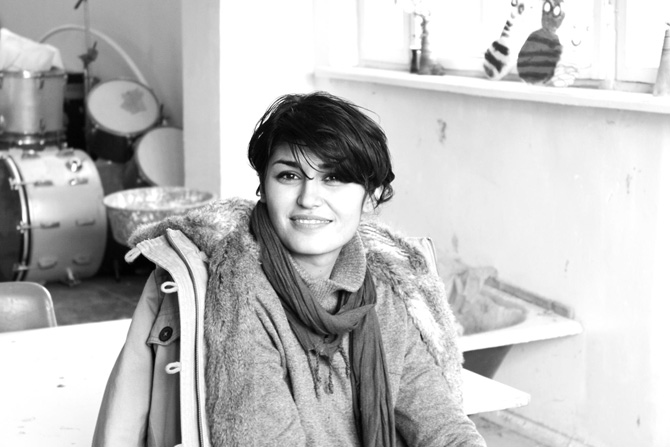 Manan Torosyan is a contemporary artist who studied sculpture at Yerevan's State Fine Arts Academy. After graduating, she started collaborating with different artists and has exhibited her work in both joint and solo exhibitions. She’s participated in collaborative art residencies in Georgia and Germany.
Manan Torosyan is a contemporary artist who studied sculpture at Yerevan's State Fine Arts Academy. After graduating, she started collaborating with different artists and has exhibited her work in both joint and solo exhibitions. She’s participated in collaborative art residencies in Georgia and Germany.
Her famous work "Soft Toy" took one year to complete. In it, she’s knitted two vaginas with fashion brand names attached - with glitter and shiny accessories - symbolizing the work of women that is dissolving in the trappings of fashion.
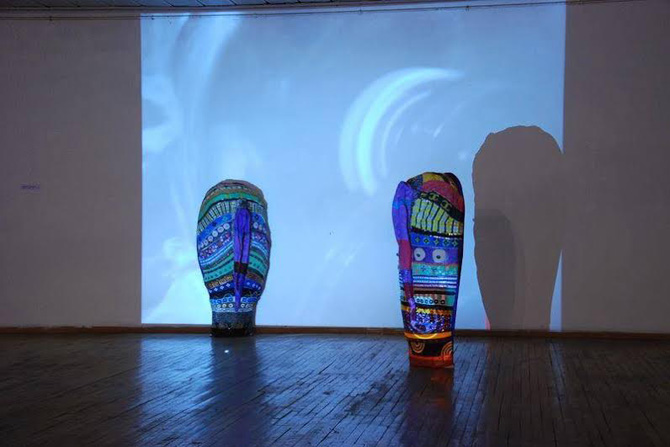
This work was not accepted by a lot of people; even by journalists who interviewed her about her work. She told me that they had disgusted expressions on their faces and were very judgmental.
She received a similar reaction from some older generation artists. She doesn't envision her work being exhibited in the state run Painters Union. Torosyan thinks its members are extremely conservative and do not accept or exhibit anything that differs from their definition of art. She says they are old fashioned and exhibit the same classics over and over again without trying to show something new, creative, meaningful and contemporary.
Torosyan told me that some Yerevan galleries don't care about art that raises social questions or issues and that they treat art as objects to make money. She adds that they exhibit items that can be sold and are popular in their estimation. Thus, art is a business for some, she says.
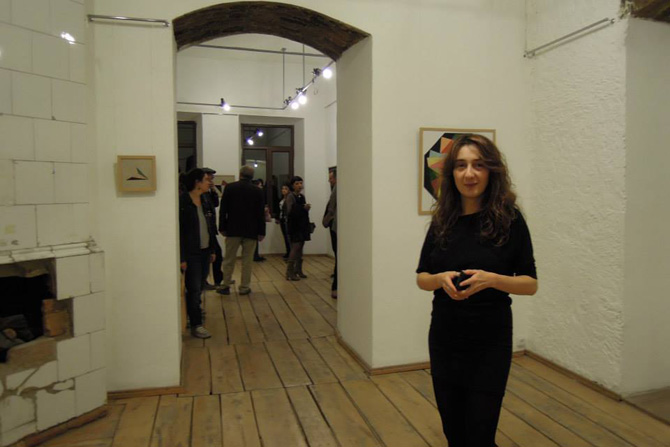 Eva Khachatryan also agreed with Manan Torosyan on this point, adding, “There is a problem of visibility, so if there are tourists or locals who are interested to see contemporary art they do not know where to go and who to address.”
Eva Khachatryan also agreed with Manan Torosyan on this point, adding, “There is a problem of visibility, so if there are tourists or locals who are interested to see contemporary art they do not know where to go and who to address.”
Curator and art critic Eva Khachatryan is also vice president of the Institute for Contemporary Art (ICA)․ She began her career as a curator in 2001 when she started working in private art gallery Armenian Center for Contemporary Experimental Art (ACCEA) until 2008. Afterwards, she became an independent curator and now coordinates with local and international, mainly European institutions. She mainly works with local artists including Lena Hakobyan, Sona Abgaryan, Tigran Khachatryan, Vahram Aghasyan and Mher Azatyan, Astghik Melkonyan and Manan Torosyan.
As a solution, Khachatryan suggested to create graphic representations of information related to events and where they are taking place, artists biographies, as well as their works of art or make a common platform for artists to share their work online, maybe to share information about upcoming events, and so that this platform or website would be accessible for everyone interested.
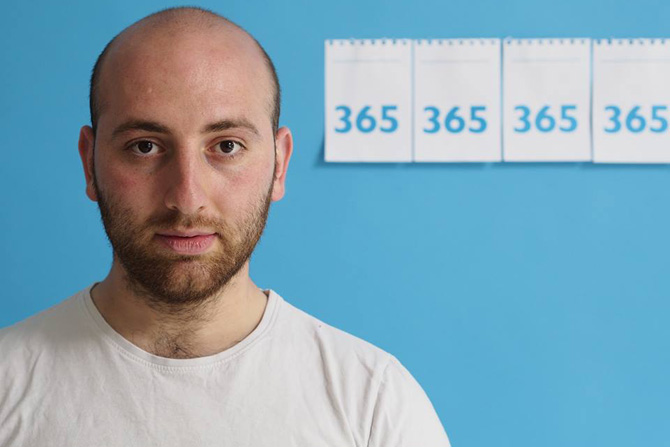 Misha Badasyan is a Russian born Armenian performance artist and activist based in Berlin. He is a firm believer in the power of art's impact on society and its contribution to the questioning of social constructs. His most recent project, which went viral, is titled “Save the Date.” In this work Misha involves the audience in his private life via documentation of his sexual encounters with a different man every day for a year.
Misha Badasyan is a Russian born Armenian performance artist and activist based in Berlin. He is a firm believer in the power of art's impact on society and its contribution to the questioning of social constructs. His most recent project, which went viral, is titled “Save the Date.” In this work Misha involves the audience in his private life via documentation of his sexual encounters with a different man every day for a year.
Misha told me that he would define himself as an “artivist”- a mixture of activist and artist. Since his early years, he’s been involved in the social and political life of the societies in which he’s lived in and thus began working in human rights, LGBT and environmental organizations.
“Art was just another way of being an activist for me. I didn’t care about autonomy of aesthetics; I cared about the concepts and messages. Then, I understood that my work has a therapeutic effect, both for myself and for the public. Suffering and pain were and still are two important aspects of my practice, which help to transform the mind and to change realities,” said Misha.
Armenia is currently in a transformation period after the collapse of the Soviet Union. There is a need for transformation of art as well.
In the past, a handful of state organizations controlled the distribution of information, cinema, printed media and art, in accordance with the official ideology and politics of the Communist Party. This was very limiting. After Armenian gained its independence, a transitional period started to take place. But the past cannot be erased, nor should it be, right away. The task is to move forward without erasing the legacy of art in Armenia, even if it existed under restricted conditions during Soviet times, and to create a hybrid of new and old - a mirror reflection of Armenia today.
Misha’s recent work “Save the Date” is his first art project where he makes himself vulnerable in an attempt to transfer a message to his audience. He is vulnerable because he exposes his body and sexuality. In this work, his privacy and sexual experiences are public, which can be very intimidating but very audacious at the same time. Badasyan plans to use dating apps and websites to meet up with a variety of strangers, all men, in these types of non-places. "Non-places are supermarkets, shopping malls, airports and other largely anonymous spots where people lose a sense of identity and feel like they don’t belong," said Badasyan. He will explore the feeling of emptiness so pervasive in today's hook-up culture, especially for gay men. Misha has already signed up for internet sex sites to facilitate the serial performance; he's also been tested for STDs and has found himself a condom sponsor.
But the question remains - Is Armenian society ready for the kind of project in which sexuality is central to a work of art? Is the Armenian contemporary scene ready for this daring project?
We cannot know for sure. We can only wait to see what happens after the project ends next year. But Misha is certain that this kind of art can contribute to social justice and be of benefit to the development of society at large.
The project started in September 2014 and will end in September 2015. Since the artist now lives in Berlin, the project takes place there. Nevertheless, Badasyan plans to move the project to different cities and countries and meet his new dates by dating apps over the coming year.
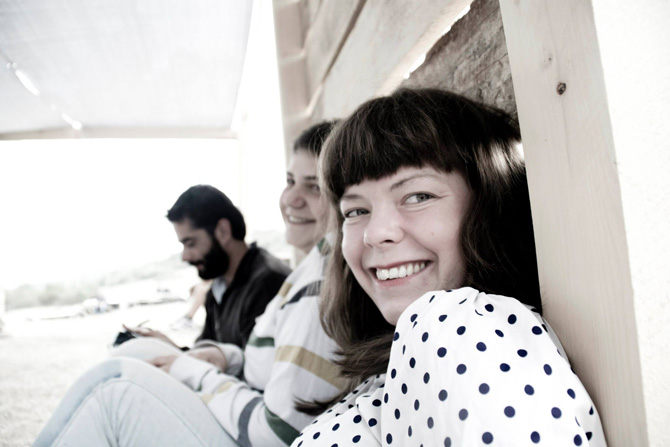 Petra Hultman, a Swedish-born artist currently residing in Armenia, agrees that the Armenian contemporary art scene is quite small and usually attracts the same crowd of people.
Petra Hultman, a Swedish-born artist currently residing in Armenia, agrees that the Armenian contemporary art scene is quite small and usually attracts the same crowd of people.
“In a way contemporary art is perhaps even more marginalized here than where I am coming from,” she said.
“I arrived in Armenia for a residency at Art and Cultural Studies Laboratory in September last year and decided to stay longer than planned. I've been working in a socially engaged art project together with local human rights activists - a participatory project investigating the power of art and creativity when used as a tool for positive social change. Instead of just making things, art can also be a force to make things happen - a tool for reaction and action. So rather than asking the somewhat tiresome questions ‘what is art?’ or ‘is this art?’ we have focused on asking ‘what can art do?’” Petra told me.
Petra thinks that there is lack of support structures for artists, because they have to always define their own space and to find ways to reach out to stakeholders and audiences, which can be a difficult task. At the same time, Petra thinks this can be both a good and a bad thing.
“Although artists don’t have their own financed and supported space for self expression, there is an incentive to create possibilities for space by improvising whatever space there is and/or investing time and energy to create new spaces. Artists have a history of inventing not only their job descriptions but also their own channels to reach out with their work,” Petra told me.
“I don't see people taking over spaces such as abandoned buildings and using them. I've heard it's not possible because someone will show up and say it’s private property, but that is how things are in most other countries as well,” Petra says about the contemporary art scene in Armenia.
The danger with not creating one's or a collective's own space for art is that artists face the risk of even more marginalization. Well known galleries exhibit the work of artists who are more commercial in order to be able to sell their work, but it is not always the case that art which is more marketable is the most activist and influential in terms of social change.
According to Eva Khachatryan, there is no space for alternative education, because the Academy of Art is very conservative and the professors are teaching what they have been taught. They are opposed to new approaches or traces of contemporary art. “I think we need both classic art that has been created during Soviet times, and before that, but I see that the inclination now is that there is no place for contemporary art to develop and expand on educational level,” she said.
Artist Manan Torosyan says that a lot of artists, both young and old, are conservative. “The young students were taught by the same generation of Soviet artists so they weren't taught to be different or create art in their own way. So the cycle continues and that is a main issue why the contemporary art is not being widely accepted both by artists of older generations and by general public.”
Eva also said that the main problem for the contemporary art scene in Armenia is that there is not a single place that is independent, that will represent contemporary art, and will have an archive as well.
“Most of the states in the US and European countries have state funded contemporary art galleries and museums. Here, unfortunately, we don't have that. For example, in Istanbul there is a contemporary art institution called Platform Garanti Contemporary Art Center which opened in 2001. It organizes exhibitions, conferences and events, hosts an international residency program, and maintains a library and archive of contemporary art. I wish we would have that kind of art center.”
Citing an example from personal experience, Eva Khachatryan notes that if she has international guests, art critiques or artists who are interested in Armenian contemporary art, she finds answering their questions quite difficult. She usually takes the foreign guests to artists' apartments in order to show their work. She says that this approach isn’t very convenient because some artists do not have the time or interest to show their work every time somebody comes to visit. This is normal because it not the artist’s job to make their work accessible. They are only creating art. The responsibility to show their work and talk about it is up to galleries, curators or other institutions.
Misha believes that Armenia has many talented artists who need to be heard, shown and talked about. The Armenian government is not considering the development or creation of a free space where artists will have access to resources and opportunities to exhibit their art without Soviet era restrictions.
To my question to Eva about the support of the government she responded:
“I would say that the contemporary art scene now is not supported by the government. When I have met and talked to representatives of MOC (Ministry of Culture) they said they are currently collaborating and supporting more than 200 NGOs and institutions whose work is linked to art. But initially they are trying to make it seem that they do some work, but in reality they are just funding the expenses in various activities only by 20% or less, which means the rest of it should be covered by the institutions or artists themselves. It is a pure formality that there is a department of contemporary art in ministry of culture of Armenia. First of all the ministry's perception of contemporary art is wrong, because they think that contemporary art is anything that was created nowadays so they include pop culture, painters or any artists that are currently working in the sphere. But in reality contemporary art is not necessarily linked to time, but rather to the idea of something new or something created with a new approach, which does not represent the classics, and which makes art different rather than popularized for-profit pop culture or classic paintings and classic music. So let's say there is a concert in Republic Square and is funded by the contemporary art department which seems ridiculous to me because currently contemporary artists have a lot of challenges and problems, which the MOC does not address. So I prefer not to work with the MOC because they really care about contemporary artists but in reality they don't.”
Seyranuhi Geghamyan, who heads the MOC’s Department of Contemporary Art (DCA), said that the objectives of the department are to contribute to the preservation of contemporary art, the development and dissemination of it, as well as development of the state cultural policy strategies.
Geghamyan said that they are coordinating the development of social and economic programs of different film and art studios. The DCA encourages various art spheres such as theater, cinema, performance art, installations, music, architecture and literature. She said that they encourage the promotion of Armenian contemporary art in the international arena as well and that they are very open for any concerns or criticism of the work of DCA, suggesting that all the concerned artists can contact her personally or by mail.
Eva Khachatryan says she would love to see the ministry of culture really show an interest in tackling issues that contemporary artists face. Manan adds, “I think the government can direct some finances in favor of the creation of residencies for artists, and they can do that by involving a lot of contemporary artists and ask their thoughts or ideas on how to make it or how to organize things there. The ministry of culture can invite someone who has a background or experience and capacity to build and maintain an art residency. Of course there is a need for contemporary artists’ residencies or things like that, but the artists that will run it will still choose to exhibit the works of art they prefer or find acceptable. Armenia is a developing country and there is no support for contemporary artists by government.”
According to Misha, Armenian artists are not united and are not “breathing together”. The solution for this, Misha finds, is to stop being passive and waiting for help. ‘It’s time to go out there and create art without complaining,' he said.
Eva Khachatryan said that she sees two main problems for the artists’ community.
“The main problem for the contemporary artist is unemployment, because most of the artists will starve to death if they only choose to work as artists. They have other jobs not related to art in order to earn their living. On the other hand they find time to create art,” she says, adding, “I would say that I noticed a common problem in the community of contemporary artists. They are so desperate to find exhibitions or place to exhibit, that wherever they are invited to participate they accept the invitation without questioning how their art is fits into the theme of the exhibition or whether it is a good exhibition or place to show their work. I would advise them to think precisely about this because the prestige of an artist is very important.”
When asked about the type of contemporary art now being created in Armenia, Petra says she finds the question hard to answer.
“There's no way I can generalize to the extent the question suggests. Armenian artists of course work over a broad spectrum both in materials, techniques and methods. Some work I find intriguing and inspiring, others I forget when I leave the gallery. But which falls into what category is mostly a matter of personal taste and interest. If I were to say anything more general, it would be to repeat the idea about how the lack of free, non-commercial and experimental venues and the hardship to find financial solutions might create challenges for artists who have a noncommercial, political and/or a practice which does not create art objects in the traditional way. It is such a pity that the government's interest for investing in its very, talented, intellectual and active contemporary artists seems to be so low. It's a treasure which the country should be proud to support and expose both within the country and abroad.”
This writer looked up several contemporary art galleries in Armenia and found that some provide space for artists of different genres: Cafesjian Center for the Arts, Arame Art Gallery, Gala Art Gallery, Naregatsi Art Institute and the Modern Art Museum of Yerevan. These galleries mainly provide space to specific artists chosen by the selection committees which consist of art experts and gallery administration.
Cafesjian Center provides space for free. Artists are never charged for exhibition. All that is expected of the artists is that they show their work and form a program for the exhibition. A jury consisting of the administration and board of trustees reviews the program and decides whether the artist’s works will be exhibited. The gallery cooperates both with Armenian and international artists.
Arame Art Gallery only works with specific artists that they choose. They provide space for random artists very rarely. Gala Art Gallery only hosts artists from Armenia and in-house committees select the artists to be displayed. Artists exhibit free of charge.
Naregatsi Art Institute provides space free of charge and is open to all kinds of artists. However, the institute works mainly with artists from Armenia artists.
The Modern Art Museum Yerevan (MAMY) provides space with a fee, which depends on who is the artist and how long the exhibition will last. The fee in MAMY is defined by the administration and a committee of art experts, who also choose the artworks which will be exhibited according to their criteria. The fee can vary depending on the artist’s experience, fame, previous investment in the gallery, and whether the artist has won prizes or is still a student.
Armenian Center for Contemporary Experimental Art (ACCEA) provides space free of any charge both for Armenian and international artists to show their work and do art installations. Eva Khachatryan, who has worked in ACCEA says, “ACCEA was always getting a lot of support from the Armenian diaspora, but now interest has decreased. Is become harder and harder to get money for different art projects or exhibitions, and the ACCEA is in a crisis because of that. There is no supporting structures or tools available for curators or artists to use in order to exhibit or to make their art projects. Currently the only choice for us is to apply for grants and support from European countries, international funding and Diaspora's donations.”
She also says that the problem with funding is that European institutions are more interested to carry out projects in Armenia than the government of Armenia.
Manan Torosyan told me that the Painters Union refused to exhibit her works on two occasions.
Once, the sculpture she made didn't have an art pedestal, and the second time they said the work should be hanged from the ceiling since they had just renovated the exhibition room and didn't want to damage it.
All the above art centers stated that they exhibit mainly male artists, arguing that women artists are not as active in the Armenian art scene.
But how one defines being active is up for question.
There are many female artists who are active in Armenia who may not have the same credibility as artists as their male counterparts simply because of social stereotypes.
Perhaps, in the end, Armenia can start by investing in its marginalized artists as a way to improve the art scene and attract international recognition.
It’s a shame that so much talent must remain underground and miss its chance of contributing to the larger global art scene.
Top Photo – Mischa Badasyan’s “Save the Date” public screening; Berlin
(Karine Aghajanyan is a freelance journalist and writer with many years of experience in human rights education and social work. She studied Law and Political Science in Armenia. She is also a feminist activist.)
 Videos
Videos Photos
Photos
Write a comment